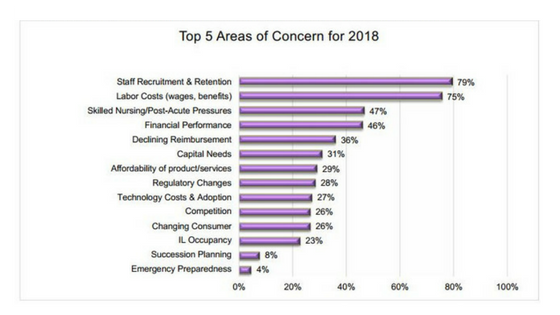

Here are some key takeaways from the report and tips to address these concerns.
- Staff Recruitment & Retention
According to the survey, 79% of respondents cited staff recruitment and retention as the top CFO concern for 2018. This is not much of a surprise given the current workforce shortage, high turnover rate and increasing competition for talent.
What’s more, a recent study from myCNAjobs found that 65% of caregivers are looking for another job and the average cost of employee turnover per employee is roughly $3,000.
Caregivers won’t just appear out of thin air, so senior care providers must get creative in their employee recruitment strategies. Cast the widest net possible by investing in multiple channels for postings and take advantage of social media. Make the application process as simple as possible for candidates via shorter applications and quick follow up. Many providers have even begun looking outside the industry to the retail space to find new talent.
In effort to retain new and existing staff members, use proven employee engagement strategies like a formal rewards and recognition program, better manager-employee communication, flexible scheduling and a commitment to employees’ work-life balance. Higher engagement leads to 25% less turnover and a 26% increase in annual revenue, among other notable results like increased staff satisfaction and better resident care.
- Labor Costs & Financial Performance
75% of survey respondents listed labor costs and 46% listed financial performance as top concerns. It makes perfect sense that these two areas rank high together as they are directly connected. Labor is the number one cost for senior care providers and your ability to staff properly has a direct impact on your performance, and in turn, your ability to attract residents and remain profitable.
Providers should focus on cost savings while still staffing to provide quality care. Scheduling software is proven to help. For example, OnShift highlights employees in danger of incurring potential overtime and recommends more cost-effective replacements. Plus, employee scheduling software provides real-time staffing visibility, so you can adjust staffing based on the care needed. Avoiding overstaffing can lead to significant cost savings.
It’s also important to examine employee utilization. Are your full-time and part-time caregivers working to their capacity? Ensuring you’re getting the most out of your staff can help you eliminate the need to use costly agency workers.
- Leadership Development
Survey participants had the option to submit comments and one that stood out to me read, “We need to improve the knowledge and performance of our middle management level staff.”
OnShift did some research in 2017 on this topic and found that managers really do play an integral role in the success of a company. They are the ones responsible for fostering and motivating employees, some of which may be future leaders in long-term care and senior living organizations. Managers are also a key component of employee engagement. In fact, one study found that one in two people had left a job because of their manager.
Organizations need to more closely manage managers and give them the tools they need to be successful. Start by identifying the characteristics of managers needed to helm your employee engagement initiatives and drive the success of your organization.
Provide regular trainings to keep them up to speed with industry best practices and make managing and building relationships with their employees easier. Implementing tools like pulse surveys are an excellent way for management to regularly measure employee satisfaction, gather feedback and swiftly address daily issues before they snowball into bigger issues.
Want to know the seven must-have qualities of managers in senior care? Check out this whitepaper.
- Introducing Technology
You can’t do any of the above efficiently without the right technology. However, according to the survey, “Just under 45% agree or strongly agree that they can 'keep up with the pace of change in technology,' with just 18.2% disagreeing or strongly disagreeing.”
Nearly half of those that participated aren’t comfortable bringing modern technology into their communities. And rightfully so – implementations are notoriously time consuming and successful adoption can be tricky. However, technology plays a key role in attracting younger workers. Today’s workforce wants to work for progressive organizations.
When evaluating technology partners, it’s important to prioritize those that are purpose-built designed for senior care. Partnering with a vendor that understands the people and processes of the senior care industry makes adoption and goal realization faster and easier.
When it comes down to it, employee engagement and real-time staffing visibility is the name of the game. Those organizations that don’t evaluate their current initiatives and adjust as needed have reason to be worried.
1 Ziegler CFO Hotline, Ziegler, January 2018.